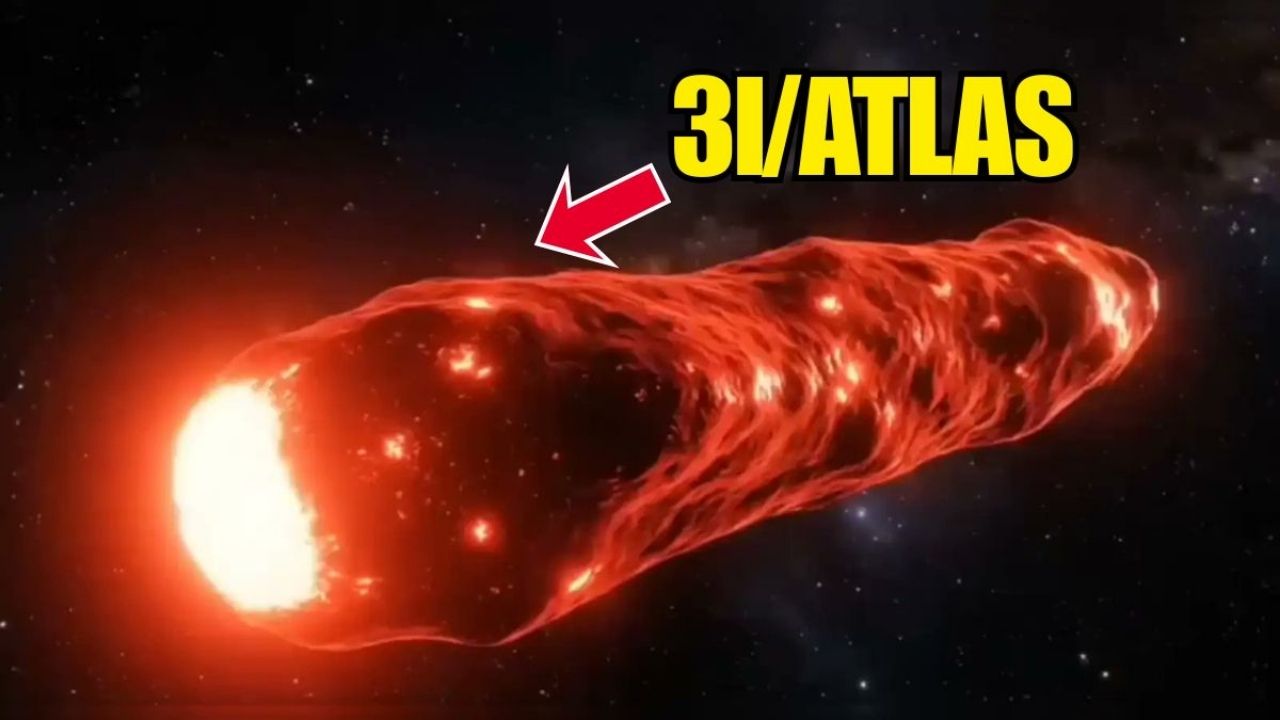The cosmos sent another traveler our way, a frozen messenger from the depths of interstellar space. The NASA officially confirms the discovery of Comet 3I/ATLAS, a rare celestial object hurtling through our Solar System from beyond the stars.
Detected in July 2025 by the Asteroid Terrestrial-impact Last Alert System (ATLAS) in Chile, this cosmic visitor marks only the third confirmed interstellar object ever recorded by humankind.
Moving at a staggering 245,000 kilometers per hour, 3I/ATLAS is blazing a hyperbolic path that ensures it will never return once it departs.
Its visit offers scientists a fleeting but historic opportunity, a glimpse into the ancient building blocks of another star system, older than our own Sun.
The Discovery That Stunned the World
The universe just dropped by to say hello. On 1 July 2025, NASA’s Asteroid Terrestrial-impact Last Alert System (ATLAS) in Río Hurtado, Chile, detected a mysterious, fast-moving comet unlike any seen before.
Days later, astronomers realized; this was no ordinary comet; it was an interstellar traveler, a visitor from beyond the Sun’s domain.
- Designation – 3I/ATLAS
- Discovery Date – 1, July 2025
- Discoverer – ATLAS Survey Team
- Classification – Interstellar Comet (“I” = Interstellar).
It is only the third known object ever confirmed to have originated outside our Solar System, following the legendary ʻOumuamua (2017) and 2I/Borisov (2019).
Journey Through Our Solar System
Key Milestones –
- 14 June 2025 – Pre-discovery data spotted by Caltech’s Zwicky Transient Facility.
- 1 July 2025 – Official discovery by ATLAS.
- 3 October 2025 – Passes closest to Mars (0.19 AU).
- 30 October 2025 – Reaches closest approach to the Sun (1.4 AU).
- December 2025 – Closest to Earth (~1.7 AU).
- Early 2026 – Fades from view, exits Solar System forever.
Its voyage will short but unforgettable, offering months of scientific wonder before it vanishes back into the black.
A Speeding Visitor From the Deep
This icy drifter is flying through our Solar System at an eye-watering 245,000 km/h (152,000 mph). Its orbit isn’t circular; it is hyperbolic, meaning it will never return. 3I/ATLAS is a true cosmic one-way traveler, moving so fast that the Sun’s gravity can’t hold it.
“Every molecule in 3I/ATLAS tells a story about a star system that existed billions of years ago.” – Dr. Emily Saunders, NASA Astrophysicist.
Comet 3I/ATLAS Fast Facts
| Property | Details | Source / Instrument |
|---|---|---|
| Speed | 245,000 km/h | NASA Orbit Data |
| Closest to the Sun | 29 – 30, October 2025 (1.36–1.40 AU) | NASA Simulation |
| Closest to Earth | December 2025 (~1.7 AU) | NASA / JPL |
| Closest to Mars | 3, October 2025 (0.19 AU) | JPL Orbit Model |
| Coma Size | 26,400 × 24,700 km | Hubble / SPHEREx |
| Composition | CO₂, Nickel, Methane, Hydrocarbons | JWST / NIRSpec |
| Estimated Age | 5–6 Billion Years | NASA / ESA Analysis |
Eyes of the Universe Watching
NASA has unleashed its most powerful fleet of observatories to study 3I/ATLAS — on Earth, in orbit, and even on Mars.
Instruments Studying the Comet –
- Hubble Space Telescope – Captured detailed images of its glowing coma.
- James Webb Space Telescope (JWST) – Detected rare interstellar chemicals.
- SPHEREx – Measured gas and dust halo twice the size of Earth.
- Mars Rovers (Perseverance & Curiosity) – Observing the comet from the Red Planet’s skies.
Other Missions – TESS, Swift, Lucy, Psyche, Parker Solar Probe, Europa Clipper, and ESA/NASA’s SOHO and Juice.
Why Comet 3I/ATLAS is a Big Deal?
3I/ATLAS isn’t just another comet, it is a cosmic time capsule. Here’s what makes it so unique –
- Interstellar Origin
- It came from another star system, likely ejected by a massive planet’s gravity.
- Unbound Orbit
- Its eccentricity > 1.03 proves it’s not tied to the Sun’s pull.
- Exotic Chemistry
- Loaded with CO₂, nickel, methane, and organic hydrocarbons, materials possibly forged in a supernova-enriched region.
- Supervolatiles
- Began outgassing while still 6.4 AU away from the Sun, far beyond Jupiter; meaning its ices vaporize even in deep cold.
- Massive Halo
- Its coma stretches over 26,000 km, dwarfing Earth’s diameter.
This strange behavior hints that 3I/ATLAS was born in a frozen, metal-rich region far from any sunlight, perhaps a world colder than the Kuiper Belt itself.
A Tale Written in Ice & Light
When Hubble first imaged 3I/ATLAS in July 2025, it revealed a teardrop-shaped dust cocoon streaming off a small, solid nucleus. Later, JWST’s infrared eyes found that this comet’s composition doesn’t match any known Solar System object.
Scientists suspect 3I/ATLAS formed in a distant star system, possibly billions of years before the Sun was born.
That means it could carry chemical fingerprints of another world’s beginnings.
“It’s a relic older than the Solar System, a frozen messenger from another sun.” – NASA Press Briefing, August 2025.
Comparing the Three Interstellar Visitors
| Object | Discovered | Distinctive Feature |
| 1I/ʻOumuamua | 2017 | Cigar-shaped, no visible coma, mysterious acceleration |
| 2I/Borisov | 2019 | True comet; high carbon monoxide content |
| 3I/ATLAS | 2025 | CO₂-rich, metal-heavy, hyperactive at great distance |
Each of these visitors has rewritten cosmic history, showing that every star system produces its own unique chemistry.
How Scientists Are Studying It?
Researchers across the globe are racing to analyze 3I/ATLAS’s –
- Spectral fingerprints (to determine origin).
- Hydrogen-deuterium ratios (to estimate temperature at formation).
- Dust composition (to compare with Solar System comets).
- Magnetic and plasma interactions (to study solar radiation effects).
These measurements could reveal how organic molecules and ices move between stars and maybe, how life’s ingredients travel across the galaxy.
Inside the Interstellar Iceball
JWST’s NIRSpec revealed astonishing details –
- Rich CO₂ atmosphere.
- Trace nickel and hydrocarbons.
- Possible supernova-origin metals.
- Early gas emissions far from sunlight.
NASA calls 3I/ATLAS “a chemical museum piece,” preserving conditions from before our Sun existed.
A Universal Collaboration
Agencies and observatories from NASA, ESA, JAXA, Caltech, and Chilean institutions are coordinating real-time data. From the Rubin Observatory’s wide-field images to Hubble’s high-resolution snapshots, every photon counts.
“Each observation refines our understanding of how interstellar travelers interact with sunlight, dust, and gravity,” said NASA’s Jet Propulsion Laboratory (JPL).
A Visitor We will Never Forget
3I/ATLAS won’t return but its brief appearance will leave an eternal mark on science. It’s proof that our Solar System is part of a dynamic galactic highway, where icy messengers roam freely between the stars. When it finally disappears into the void, it will carry with it –
- The chemistry of an ancient world.
- The memory of a long-lost star system.
- And the message that we are not alone in the galaxy’s grand story.
3I/ATLAS Brings Secrets From Another Star System
Comet 3I/ATLAS’s brief visit reminds humanity that our Solar System is not isolated but part of a vast, interconnected cosmic network. Each interstellar traveler carries secrets of distant stars and ancient galactic origins.
As it fades into the darkness beyond the Sun, 3I/ATLAS leaves a legacy of discovery and wonder, a timeless message that the universe is alive, evolving, and always reaching out to be understood.











